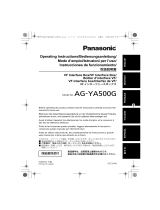19
Specifications
General
Power input
Power supply: 12 V DC, 0.35 A (DC input range; 10 V DC - 16 V DC)
Power consumption: 4.2 W
indicates safety information.
CCU control - Control signals (camera, CCU control)
- Power supply (12 V DC)
*
1
*
1
Can be provided from CCU or AC adapter
PREVIEW control : Contact output
Maximum cable length : 50 m (164 ft)
Operating temperature : 0 °C to 40 °C (32 °F to 104 °F)
Storage temperature : −20 °C to 60 °C (−4 °F to 140 °F)
Humidity : 90 % or less
Dimensions (W x H x D) : 92 mm x 308 mm x 55 mm (3-5/8 inches x
12-1/8 inches x 2-3/16 inches) (excluding
protrusions)
Mass : approx. 1.3 kg (approx. 2.87lb)
Index
Numerics
12 DC V connector .............................................................................. 18
5600 K button ...................................................................................... 11
A
Accessories ............................................................................................ 7
Alarm display ....................................................................................... 16
Auto Black Balance button .................................................................. 10
Auto iris button ..................................................................................... 17
Auto setup ........................................................................................... 11
Auto Setup button ................................................................................ 11
Auto White Balance button .................................................................. 10
B
B flare/pedestal control ........................................................................ 13
B gain control ....................................................................................... 13
C
Call button ........................................................................................... 16
Camera number display ...................................................................... 15
Camera number tens' place digit display ............................................. 15
Camera power button .......................................................................... 10
Camera select button .......................................................................... 15
CC filter ................................................................................................ 14
CC filter display ................................................................................... 14
CCU connector .................................................................................... 18
Character/Menu button ........................................................................ 16
Coarse control ..................................................................................... 17
Color Bar Signal Output button ............................................................ 10
Connection ............................................................................................. 9
Control lock .......................................................................................... 13
Control lock button ............................................................................... 13
D
DATA SET button ................................................................................ 14
Detail OFF button ................................................................................ 11
Digital extender indicator ..................................................................... 17
Dip Switche .......................................................................................... 18
DTL control .......................................................................................... 13
E
EXECUTE button ................................................................................. 15
EXIT button .......................................................................................... 15
F
Fader full button ................................................................................... 17
I
IP connector ........................................................................................ 18
Iris close button ................................................................................... 17
IRIS display ......................................................................................... 14
Iris lever ............................................................................................... 17
Iris/master pedestal lock button ........................................................... 16
K
Knee OFF button ................................................................................. 11
L
Lens extender indicator ....................................................................... 17
M
Master pedestal control ....................................................................... 17
Matrix button ........................................................................................ 11
Memory card access indicator ............................................................. 17
Memory card slot ................................................................................. 17
M.GAIN display .................................................................................... 15
M.GAIN/M.PED ................................................................................... 15
M.GAIN/M.PED DISPLAY SELECT button ......................................... 15
M.PED display ..................................................................................... 15
N
ND filter ................................................................................................ 14
ND filter/CC filter DISPLAY SELECT button ....................................... 14
ND filter display ................................................................................... 14
O
Optical alarm display ........................................................................... 16
Outside dimension drawing .................................................................... 9
P
Preview button ..................................................................................... 17
Preview connector ............................................................................... 18
R
Rack mount brackets .............................................................................. 8
Rack mounting ........................................................................................ 8
Red/green tally display ........................................................................ 16
R flare/pedestal control ........................................................................ 13
R gain control ...................................................................................... 13
RS-422 connector ................................................................................ 18
S
Scene file
Opening .......................................................................................
12
Storing ......................................................................................... 12
SCENE/USER FILE select buttons ..................................................... 12
Scene/User File selector button .......................................................... 12
Scene/user file store button ................................................................. 12
Select dial ............................................................................................ 16
Sense control ....................................................................................... 17
Setting display ..................................................................................... 14
SHUTTER ............................................................................................ 15
SHUTTER display ............................................................................... 15
SHUTTER DISPLAY SELECT button ................................................. 15
Shutter On/Off button .......................................................................... 11
Skin Detail button ................................................................................ 11
Specifications ...................................................................................... 19
STEP/SYNC select button ................................................................... 11
SYNCRO display ................................................................................. 15
U
User file
Opening .......................................................................................
12
Storing ......................................................................................... 12
V
Viewfinder power button ...................................................................... 10




















